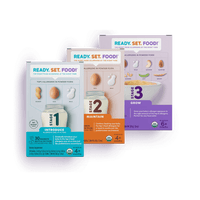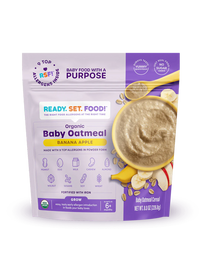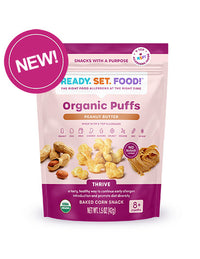Thanks to the LEAP study, we know that introducing babies to peanut early and often significantly reduces their risk of developing a peanut allergy. But how was the LEAP study conducted, what exactly did the study reveal, and what do the findings mean for your family? In this article, we’ll break down everything parents need to know about the LEAP study.
The LEAP Study: Overview
- The study focused on babies at high risk for peanut allergy. All of the children in the study had severe eczema, egg allergy, or both. Therefore, all participants were at high risk of developing a peanut allergy.
- Initially 640 children in the United Kingdom, between 4-11 months of age, took part in the LEAP study.
- The children were randomly divided into two equal groups, where they were directed to either consume peanut regularly or avoid peanut completely until age 5.
- The children in the “consume” group ate at least 6 grams of peanut protein per week, divided into three or more doses per week, until they reached the age of 5. The peanut protein was provided in age appropriate form.
Learn more about the LEAP trial from this 1 minute video from the New England Journal of Medicine:
We’ve included a summary of the LEAP study below:
| Questions | Answers | |
|---|---|---|
|
What was the purpose of the LEAP study? |
"evaluated strategies of peanut consumption and avoidance to determine which strategy is most effective in preventing the development of peanut allergy in infants at high risk for the allergy" |
|
|
Who was the study’s lead investigator? |
Dr. Gideon Lack (King’s College, London) |
|
|
Who funded the LEAP study? |
The study was supported by grants from organizations including:
No manufacturer of peanut products, including The National Peanut Board, could contribute to the study design, the analysis of data or the preparation of the results, so there was no conflict.
The LEAP study was peer-reviewed by impartial experts before it was published. |
|
|
Who took part in the LEAP study? |
|
|
|
What made them high risk for peanut allergy? |
Severe eczema, egg allergy, or both |
|
|
How was the LEAP study conducted? |
Babies were first given a skin-prick test (SPT) to determine if they had an existing peanut allergy. · Only babies with a negative SPT and babies with a positive SPT but very small wheals (1-4mm), moved forward into the study.
The children were randomly divided into 2 groups, with equal numbers of babies with positive SPT and negative SPT. · One group consumed peanut regularly until the age of 5 · The other group avoided peanut completely until the age of 5 |
|
|
Were any babies excluded from the study? |
Yes. Approximately 9% of infants who were pre-screened in the SPT were excluded from enrolling because they likely already had a peanut allergy. These babies had large wheals (raised red, itchy bumps) when they were exposed to peanut during an initial skin prick test. |
|
|
How much peanut did the “consume” group eat? How often? |
|
|
|
Did the study have any safety issues? |
|
|
|
How did the researchers check to see if the children developed a peanut allergy? |
Doctors assessed the children at three times:
Doctors also had between-visit consultations with parents and additional clinic visits were scheduled.
At 5 years of age, the children were tested to determine if they had a peanut allergy, by means of an oral food challenge. |
|
|
What did the results how? |
|
|
Breaking Down the Findings
The LEAP study results show that introducing peanut to babies early and often helps prevent them from developing a peanut allergy. In the study, of those who avoided peanuts, 17.2% ended up developing a peanut allergy, compared to 3.2% for those who consistently ate peanuts. Comparing the two groups, those infants consuming peanuts were 82.35% more likely to not have a peanut allergy at 60 months of age.
What do the findings mean for you?
The LEAP study showed that early oral introduction of peanuts could prevent peanut allergy in infants with severe eczema, egg allergy or both. Sustained peanut consumption beginning in the first 11 months of life, as compared with peanut avoidance, resulted in a significantly smaller portion of children with peanut allergy at the age of 60 months. This intervention was safe, tolerated and highly efficacious.
Introducing peanut to babies as early as 4 months of age, and consistently feeding them peanut multiple times per week over several years, reduced their risk of peanut allergy by more than 81%.
The LEAP study shows that you shouldn’t delay the introduction of peanut to your baby and advice to delay the introduction of peanut for a child’s first few years of life (as was previously recommended by the AAP in 2000) is incorrect. Delaying peanut introduction results in a greater frequency of clinical peanut allergy than consuming peanuts.
Because of the LEAP study’s significant findings, new landmark medical guidelines for introducing peanut were established including guidelines from the AAP.
About the author: Our Chief Allergist, Katie Marks-Cogan, M.D., is board certified in Allergy/Immunology and Internal Medicine, and treats both pediatric and adult patients. Originally from Cleveland, Ohio, she received her M.D. with honors from the University of Maryland School of Medicine. She then completed her residency in Internal Medicine at Northwestern and fellowship in Allergy/Immunology at the prestigious University of Pennsylvania and CHOP. After finishing training, she moved to Southern California and currently works in private practice. She is a member of the scientific advisory board for Ready. Set. Food! She currently resides in Los Angeles with her husband, 4-year-old son, and 1-year-old daughter where she enjoys hiking, building LEGO castles with her kids, and cooking with her family.

New Study Shows That Infant Anaphylaxis Usually Resolves With One Epinephrine Dose
A recent study has shown that, when infants experience severe aller...

Pregnancy Nutrition: What To Eat In The First Trimester
What to eat in the first trimester that will nourish your body, pro...

Formula Feeding Amounts: How Much Formula Should You Feed Baby Per Day?
How much formula should baby drink per day? It depends on their age...

What Baby Eats In A Day: 6-12 Months Old
Looking for ideas of what to feed your 6-12 month old little one? H...

What To Look For When Choosing An Early Allergen Introduction Solution
Medical guidelines recommend early allergen introduction – the earl...

Why are food allergies on the rise?
Food allergies significantly affect families’ quality of life. Why ...
All health-related content on this website is for informational purposes only and does not create a doctor-patient relationship. Always seek the advice of your own pediatrician in connection with any questions regarding your baby’s health.
These statements have not been evaluated by the Food and Drug Administration. Products are not intended to diagnose, treat, cure or prevent any disease. If your infant has severe eczema, check with your infant’s healthcare provider before feeding foods containing ground peanuts.










